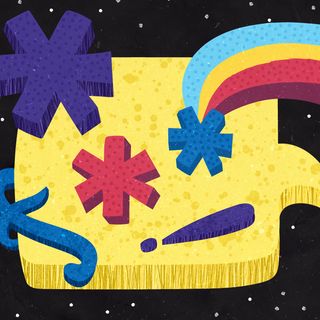
Is This Normal? “I Tell Myself Stories at Night in Order to Fall Asleep”
A network in our brain likes to “generate its own stimuli” when we’re awake but at rest.

In this series, we dig into our strange phobias, fixations, and neuroses, and ask ourselves — Is This Normal?
Once upon a time, a baby princess was sold to an evil magician by her father, the king, in exchange for his kingdom’s safety. She grew up in the castle, but every day from the age of five, she climbed the cliff behind the palace to the magician’s cave lair to be drilled in the dark art of killing. Her family and the people of the palace avoided her, and she grew up abused and lonely. She makes three friends, but keeps the relationships secret, as the magician threatens them. It’s not until she’s well through her teens that she gains the strength to kill the magician, and eventually come into her own as a person, a warrior and heir to the throne. To say more would be to give away the ending, and also — I don’t know how it ends.
For as long as I can remember, I’ve turned out the light, lain down, closed my eyes, and told myself a (not particularly original) story in order to fall asleep. In adulthood, the stories didn’t stop, they just became a bit more elaborate — the equivalent of graduating to chapter books. I follow one story, build the world, its characters and its conflicts — sometimes over years — until one day I’m done with it, even if I haven’t given it an ending. It’s a bit like a movie playing in my head, and while the protagonist isn’t me, I’m always the protagonist. Think of it like first-person narration.
Deep corners of the web assure me I’m not alone — not only are ‘adult bedtime stories’ Googled with enough frequency for someone to start a business selling them, there are personal blog accounts of the self-storytelling phenomenon, and reddit threads discussing it. But let’s be honest, there’s nothing normal about the web’s deep corners. So, why do I do it?
We’ll start with the most pragmatic explanation: Bedtime routines become sleep cues that can be ingrained from a very early age. Sleep, as much as it’s an involuntary physiological process, is also a learned behavior — for instance, babies younger than roughly six months are unable to link their sleep cycles, until they develop the cognitive ability that allows them to learn how. And research has linked better quality bedtime routines to better sleep quality, suggesting good bedtime routines aid our bodies in learning to sleep better. Whether telling myself bedtime stories is a good or bad routine is open for debate (sometimes I do get caught up in them and fight to stay awake), but it is a routine that was set early in my life, from stories being read to me, and later through reading stories to myself. It’s likely, over the years, this routine has become a cue to my brain — a way to calm it down and signal it’s bedtime.
Related on The Swaddle:
Imagination Can Be Used to Control Fear
There’s likely a neurological aspect, too. The time before sleep is uniquely open to being calm and inward-looking — no distractions, no need to focus, no TV or internet. This ‘wakeful resting’ state is run by the brain’s Default Mode Network (DMN), which kicks in when we’re idle. “While active, the default network turns itself on and generates its own stimulation,” writes Susan Krauss Whitbourne, PhD, a professor emerita of psychological and brain sciences at the University of Massachusetts, Amherst. One type of stimulation it generates is daydreaming — and what else are my nighttime stories, but end-of-daydreaming? The DMN is also heavily involved in theory of mind, the ability to attribute mental states to ourselves and others. Plus, “activity in the DMN is strongly associated with mental imagery that is not directly tied to current perception,” according to a 2013 study of the DMN and actual nighttime, unconscious dreaming.
The DMN is involved in more than daydreaming and theory of mind — it is linked to goal-oriented tasks, too — but during the onset of sleep the connectivity decreases between the DMN and the network that channels it toward attention-demanding tasks. Whether that’s because there are fewer stimuli that need our attention, as we’re lying in bed in the dark, or a natural neural shift driven by the brain’s circadian rhythm, is difficult to say, but regardless, it leaves the DMN freer for daydreaming. Fiction — which my bedtime stories decidedly are — has been shown to activate sub-networks within the brain’s DMN, in studies of people reading literary passages while undergoing fMRIs. And crucially, during this pre-to-onset-of-sleep time, the DMN maintains connectivity to the prefrontal cortex, which is essential to controlled imagination, making daydreams different from the uncontrolled imagery of unconscious dreaming. Perhaps my self-storytelling prepares me to slip into sleep, exercising the prefrontal cortex until its connectivity with the DMN drops during the earliest stages of sleep.
That said, “the preponderance of evidence suggests that the default network is there to help us explore our inner experiences,” according to Krauss Whitbourne. While the stories I tell myself aren’t rooted in reality — I, as Liesl, am not one of the characters — I imbibe the experience of the characters I invent. And the characters I tend to set at the heart of these stories are characters that resonate with my own experience in some way (I’ve never played out a story focused on a male protagonist, for instance) and often reflect traits I admire in fiction and in real life — toughness, for instance, or mystery. But then, isn’t that what all stories are for? “Stories are recognizable patterns, and in those patterns we find meaning,” writes Frank Rose for Wired. “We use stories to make sense of our world and to share that understanding with others. They are the signal within the noise.” Sometimes even just within the noise of our own heads.
Liesl Goecker is The Swaddle's managing editor.
Related


Small Talk: The F Word
